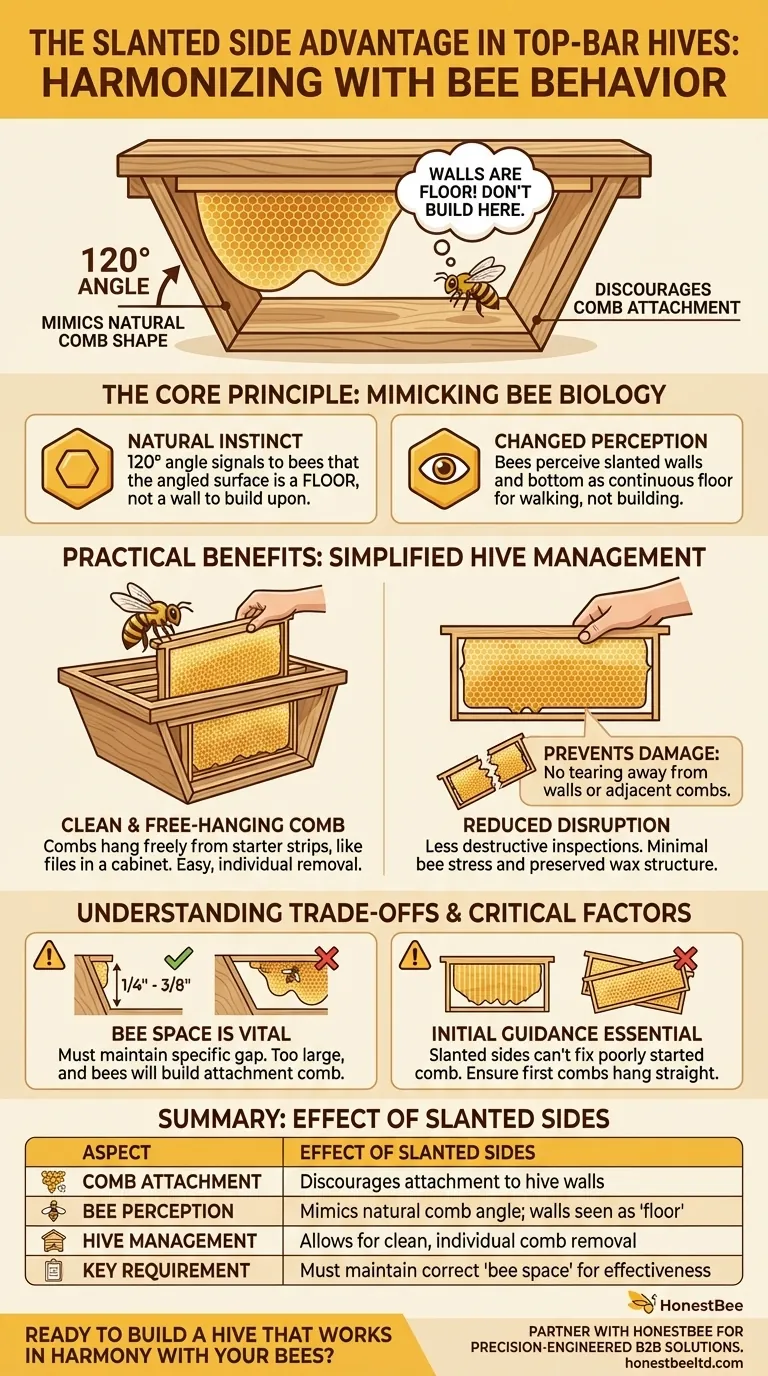Slanted sides are a critical design feature in a top-bar hive that discourages bees from attaching their comb to the hive walls. By setting the sides at a specific angle, the hive design leverages the bees' natural instincts to make comb inspection and removal significantly easier and less disruptive for the colony.
The 120-degree angle of a top-bar hive's slanted sides mimics the natural shape of honeycomb. This causes the bees to perceive the walls as the hive floor, discouraging them from building attachments and allowing each comb to be lifted out cleanly from its top bar.

The Core Principle: Mimicking Bee Biology
The design of a top-bar hive is not arbitrary; it's a carefully considered system meant to work with the bees' natural tendencies. The slanted walls are a primary example of this philosophy.
The Significance of the 120-Degree Angle
The specific 120-degree angle between the hive walls and the bottom board is chosen because it mirrors the angle bees naturally form in their honeycomb cells.
This geometric consistency is key. It signals to the bees that the angled surface is not a vertical wall to be built upon.
Changing the Bees' Perception
Because the angle matches their own construction, bees tend to regard the slanted walls and the bottom board as one continuous "floor".
In a bee's mind, the floor is for walking and debris, not for building comb. This simple perceptual trick is what drastically reduces the impulse to attach comb to the hive's sides.
The Practical Benefit: Simplified Hive Management
This design directly translates into a more manageable hive for the beekeeper and a less stressful environment for the bees.
Freely Hanging Comb
The primary result is that bees build their comb straight down from the starter strips on the removable top bars.
The comb hangs freely in the hive cavity, like a file in a filing cabinet, without being glued to the side walls with brace comb.
Cleaner and Safer Inspections
This lack of side attachment is the defining advantage of the top-bar system. A beekeeper can lift any single top bar and its comb out for inspection without tearing it away from the wall or an adjacent comb.
This process is far less destructive and disruptive than in hives where comb must be pried from the walls, reducing bee stress and preserving the delicate wax structure they worked so hard to build.
Understanding the Trade-offs
While effective, the slanted-side design is not a magic bullet. Its success depends on other factors being correct.
The Critical Role of "Bee Space"
This system only functions properly if the hive's dimensions adhere to the principle of bee space. This is a specific gap (roughly 1/4 to 3/8 of an inch) that bees will not build in or seal with propolis.
If the space between the comb and the slanted wall becomes too large, bees will violate the rule and build attachment comb, defeating the purpose of the design. Once removed, these attachments are typically not rebuilt if the dimensions are correct.
Initial Comb Guidance is Essential
The slanted sides help, but they cannot fix a poorly started comb. The beekeeper must ensure the bees begin building their initial comb straight down the center of the top bar.
If the first comb is built at an angle, it will inevitably run into the side wall or the next comb, creating a difficult-to-manage problem that the slanted walls cannot prevent on their own.
How to Apply This to Your Hive Management
Understanding this principle helps you manage your top-bar hive more effectively.
- If your primary focus is easy and frequent inspections: The slanted-side design is your greatest asset, allowing for clean removal of individual combs with minimal disturbance to the colony.
- If your primary focus is natural beekeeping: This design supports the bees' instinct to build comb to their own specifications, unlike the foundation-based frames in other hive types.
- If your primary focus is preventing crossed comb: Pay close attention to guiding the first rows of comb perfectly straight, as the slanted sides only work when the comb hangs correctly from the start.
By appreciating how slanted sides influence bee behavior, you can work with your colony's instincts to create a healthier and more manageable hive.
Summary Table:
| Aspect | Effect of Slanted Sides |
|---|---|
| Comb Attachment | Discourages bees from attaching comb to hive walls. |
| Bee Perception | Mimics natural comb angle; walls are seen as 'floor'. |
| Hive Management | Allows for clean, individual comb removal. |
| Key Requirement | Must maintain correct 'bee space' for effectiveness. |
Ready to build a hive that works in harmony with your bees? At HONESTBEE, we supply commercial apiaries and beekeeping equipment distributors with the high-quality, precision-engineered top-bar hives and supplies needed to leverage these natural design principles. Our wholesale-focused operations ensure you get durable, bee-centric equipment that simplifies management and promotes colony health. Contact our expert team today to discuss your apiary's needs and discover the HONESTBEE advantage.
Visual Guide

Related Products
- Top Bar Beehive for Beekeeping Wholesales Kenya Top Bar Hive
- Long Langstroth Style Horizontal Top Bar Hive for Wholesale
- HONESTBEE Professional Multi-Functional Hive Tool with Ergonomic Wood Handle
- HONESTBEE Advanced Ergonomic Stainless Steel Hive Tool for Beekeeping
- HONESTBEE Professional Long Handled Hive Tool with Precision Cutting Blade
People Also Ask
- How is honey harvested from a top-bar hive? A Guide to Simple, Low-Equipment Processing
- What are the benefits of extra wax production in top bar hives? A Natural Byproduct for Craft & Efficiency
- How should a beekeeper prepare a top-bar hive for overwintering? A Guide to Ensure Colony Survival
- What are the key features of the Kenyan Top Bar Hive? A Guide to Simpler, Natural Beekeeping
- Why are hive inspections easier with Top Bar Hives? Achieve a Calmer, Safer Approach to Beekeeping



















